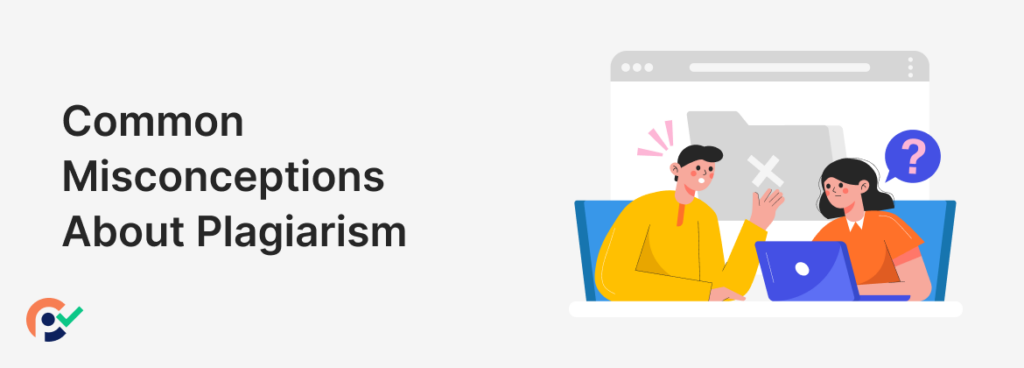
Common Misconceptions About Plagiarism
Plagiarism is a common term; everybody knows the basics, like how it can harm you and what type of consequences this unethical activity has. But we also confuse this term and create several myths about it.
These misconceptions can lead to severe issues, even when someone doesn’t mean to do anything wrong. For example, some believe that just changing a few words makes something original or that using your past work isn’t plagiarism. These myths create confusion and can cause trouble in school or at work.
That’s why it’s essential to clear up these misunderstandings and know what plagiarism involves. Therefore, we put together several misconceptions that everybody has a mind related to. So, to eliminate this confusion, go through this guide till the end.
Self-Plagiarism Doesn’t Count
At first, self-plagiarism may seem harmless and innocuous, but it can lead to real-world problems. While it may seem harmless to use material you’ve created, it is still considered unethical in many academic and professional settings. The core issue with self-plagiarism is that it misleads the audience into believing the content you’ve provided them has some unique and original perspective, which can distort the integrity of research or creative outputs.
Therefore, when your readers read the same content over and over, how can they get the new information? They don’t want to return to you to get their concern’s solution. We mostly feel self-plagiarizing can’t harm us, but it can. So, stay away from this act.
Accidental Plagiarism Isn’t a Serious Issue
Sometimes, we are stuck with an idea or a thought that we read somewhere. And then, when it comes to writing something related to them, we unintentionally use it. That’s accidental plagiarism. It’s like wearing another person’s shoes without realizing it.
It’s not about stealing; it’s more like stumbling into a situation where your words sound too similar. But it doesn’t mean it didn’t harm you. All kinds of plagiarism harm you, no matter whether they are accidental or unintentional.
Changing a Few Words Makes It Original
Students mostly copied content from online sources and submitted it to their teachers. They slightly change a few words and assume it is original. As we all know, in an academic setting, originality always matters. If your work doesn’t have unique and original thoughts, you won’t be able to perform well in your educational journey.
When students rely on copying, even if they alter some phrases, they miss the opportunity to develop their critical thinking and creativity. This affects their academic performance and their ability to learn and grow.
AI-generated Content isn’t Plagiarized
We mostly think AI chatbots generate original content, but this isn’t true. These chatbots, including ChatGPT, don’t create brand-new ideas. Instead, they rely on patterns and information learned from vast amounts of existing data.
The content they create is based on the training data they have stored in their database. This trained data comes from what’s already been published online. Most of the generated content closely resembles or even matches online sources. This is why it’s important to remember that chatbots don’t “invent” information; they repackage what they’ve learned during training into new responses.
Plagiarism is Only About Copying Words
When people think of plagiarism, the first thing that comes to mind is copying or borrowing word-to-word from another person’s work. However, while that idea may be correct, it doesn’t exactly cover the whole definition of this term. Basically, in some cases, plagiarism is considered theft.
It is essential to understand that plagiarizing is technically committing fraud. You are claiming credit for something you did not initially make and took it from someone without their permission.
Plagiarism is Hard to Detect
With the advancement of technology, finding plagiarism in your content has become more efficient. You can easily spot any instances of plagiarized content with the help of an online plagiarism checker. Nowadays, even most universities and website owners use these detection technologies.
Academic institutes use them to ensure students submit authentic work and uphold academic integrity. So, if you’re considering using data from the Internet, think twice; these advanced utilities are likely to catch it, and the consequences can range from failing grades to legal penalties.
Plagiarism Only Happens in Written Content
A common misconception is that plagiarism only occurs in text-based content. While text-based plagiarism is the most well-known form, it can also occur in various mediums, including images, music, videos, software code, and ideas.
With the rise of digital content, plagiarism has expanded to more creative domains. For instance, using a graphic design or photograph online without the author’s permission is unethical. Similarly, sampling a music track or replicating a piece of code is also considered plagiarizing.
Conclusion
The above-mentioned misconceptions related to plagiarism stick around because they contain a bit of truth. However, that small piece of truth is just one part of a bigger, more complicated issue. Plagiarism causes and effects can’t be understood from one perspective.
Therefore, we should clear up these myths and stop spreading the wrong information about them. This way, we develop better ways to not only catch it but also stop it from happening. If we still believe in them, the problem of plagiarism will continuously grow.







